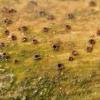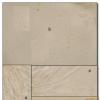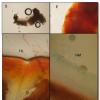
08-11-2025 00:29
 Francois Guay
Francois Guay
I found this species in Quebec, Canada, on herbace

04-11-2025 09:07
Hello.A suspected Hymenoscyphus sprouting on a thi

04-11-2025 12:43
 Edvin Johannesen
Edvin Johannesen
Hi! One more found on old Populus tremula log in O

03-11-2025 21:34
 Edvin Johannesen
Edvin Johannesen
These tiny (0.4-0.5 mm diam.), whitish, short-stip

28-10-2025 15:37
Carl FarmerI'd be grateful for any suggestions for this strik

03-11-2025 16:30
 Hans-Otto Baral
Hans-Otto Baral
Hello I want to ask you if you have found this ye
Ostropales
Gernot Friebes,
16-04-2009 23:05
this time I found an Ostropales I can not identify. It grew on an decorticated branch of Fagus and has an ochre to dirty pinkish hymenium with a brownish margin. The spores are 9-12 x 2 µm and aseptate, the paraphyses are apical slightly thickened with many cells and the asci have quite a strange form. The hymenium is dextrinoid and a little bit bluish to greenish in Lugol and in Melzer's reagent pretreated with KOH 5% it reacts slightly blue. The excipulum is dark brown and without crystals.
Best wishes,
Gernot
Gernot Friebes,
16-04-2009 23:08
Gernot Friebes,
16-04-2009 23:10
Hans-Otto Baral,
17-04-2009 10:56

Re:Ostropales
Hi Gernot
The order Ostropales is obviously correct, but the species I do not know. It could be a Cryptodiscus, but it is not C. foveolaris which has a similar spore size but always 1-septate spores when mature, and especially never a dark margin. To clarify the genus it would be helpful to have a section of the margin. In Karstenia there are very distinct periphyses on the inner sied of the lobes which point in a horizontal direction and reach down to the base of the asci, while in Cryptodiscus the periphyses are less distinct and intergrade with the tips of the paraphyses. I assume you will find images on the DVD about that.
The red reaction is hemiamyloid, not dextrinoid, see my homepage
http://www.gbif-mycology.de/HostedSites/Baral/
Zotto
The order Ostropales is obviously correct, but the species I do not know. It could be a Cryptodiscus, but it is not C. foveolaris which has a similar spore size but always 1-septate spores when mature, and especially never a dark margin. To clarify the genus it would be helpful to have a section of the margin. In Karstenia there are very distinct periphyses on the inner sied of the lobes which point in a horizontal direction and reach down to the base of the asci, while in Cryptodiscus the periphyses are less distinct and intergrade with the tips of the paraphyses. I assume you will find images on the DVD about that.
The red reaction is hemiamyloid, not dextrinoid, see my homepage
http://www.gbif-mycology.de/HostedSites/Baral/
Zotto
Gernot Friebes,
17-04-2009 20:49
Re:Ostropales
Hi Zotto,
thanks for your answer! A section of the margin is more complicated than I thought because you never see any clear defined cells and it is hard to make a good picture but maybe the new ones help a little.
: The red reaction is hemiamyloid, not dextrinoid, see my homepage
Sure, stupid mistake, thanks for the correction.
Best wishes,
Gernot
Ps.: I wont be able to answer for a week, that means I dont ignore your answers if I dont write back immediately.
thanks for your answer! A section of the margin is more complicated than I thought because you never see any clear defined cells and it is hard to make a good picture but maybe the new ones help a little.
: The red reaction is hemiamyloid, not dextrinoid, see my homepage
Sure, stupid mistake, thanks for the correction.
Best wishes,
Gernot
Ps.: I wont be able to answer for a week, that means I dont ignore your answers if I dont write back immediately.
Hans-Otto Baral,
17-04-2009 22:08

Re:Ostropales
I know these sections are difficult to perform. When moist the tissue is too elastic, and when dry you easily loose your section, or the fungus breaks before you succeed. On the macro I see that the margin protrudes as lobes, On the micro I don't see a protruding margin, apparently because the section missed the lobes. Anyhow, a Karstenia is excluded, but where to search for this fungus? Any genera other than Cryptodiscus? I have no idea.
Zotto
Zotto
Gernot Friebes,
18-04-2009 06:10
Re:Ostropales
: On the macro I see that the margin protrudes as lobes, On the micro I don't see a protruding margin, : apparently because the section missed the lobes.
you are right, within ca. 10 sections no one still had the margin. Seems to be an interesting fungus, maybe even something new.
Best wishes,
Gernot
you are right, within ca. 10 sections no one still had the margin. Seems to be an interesting fungus, maybe even something new.
Best wishes,
Gernot





